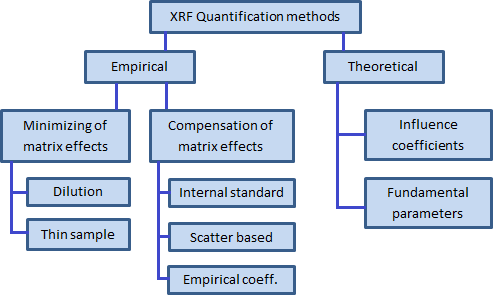6.3 Common quantification approaches
A close look at the complex Sherman formula highlights the difficulties for XRF quantification. In the more general case deriving the element weight fraction wi from the intensity of detected characteristic emission ID(Ei) is affected by several causes:

-
χS(E0,Ei) depends on the sample attenuation coefficient μS(E),
which value depends not only on element i
weight fraction wi but on all the sample constituents, which are a priori unknown:

- An iterative calculation of the weight fractions of all measured wi based on further correction of the attenuation using the running values of wi is unfeasible in the more general case, since some major elements might not be detected.
Different strategies can be followed for quantification, which can be classified as Empirical or Theoretical.

Empirical methods are useful for a specific type of matrix or for routine analytical tasks. These methods are often based on establishing a calibration model based on simple or multiple regression and under the assumption that no significant differences in attenuation will be found. Some empirical methods rely on special sample preparation procedures, aimed at minimizing attenuation effects. Other methods use some signal whose intensity is supposed to be affected the same way as that of the analyte by the sample matrix, and use the internal normalization to compensate for small differences in the matrices.
Theoretical methods are based on using a thorough parametrization of the excitation/measurement conditions and the calculation of x-ray production, attenuation and enhancement corrections using the tabulated values of fundamental parameters. These methods are more versatile, but the uncertainty of results is typically larger.